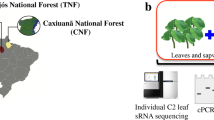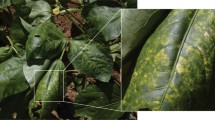Abstract
The cotton boll weevil (CBW; Anthonomus grandis; Coleoptera: Curculionidae) is considered the major insect pest of cotton, causing considerable losses in yield and fiber quality. An increase in the boll weevil population due to increasingly inefficient chemical control measures is of great concernamong cotton producers. The absence of conventional or transgenic cultivars with minimal resistance to CBW has stimulated the search for new molecular and biological tools for efficient control of this insect pest. In this study, we used a metagenomic approach based on RNA deep sequencing to investigate the presence of viruses and coding viral RNA in apparently healthy native adult CBW insects collected from cotton crops in Mato Grosso state, Brazil. Using an Illumina HiSeq 2000 paired-end platform, 138,798 virus-related reads were obtained, and a consensus sequence of a putative new virus, 10,632 nucleotides in length, was assembled. The sequences of the 5’ and 3’ untranslated regions (UTRs) were determined by rapid amplification of cDNA ends (RACE), followed by Nanopore sequencing. The complete genome sequence included a 5’-UTR (1,158 nucleotides), a 3’-UTR (561 nucleotides), and a single ORF of 8,913 nucleotides encoding a large polyprotein. Sequence analysis of the putative polyprotein showed several regions with high sequence similarity to structural and non-structural proteins of viruses of the family Iflaviridae. Pairwise alignments of polyprotein amino acid sequences showed the highest sequence identity (32.13%) to a partial polyprotein sequence of a putative iflavirus (QKN89051.1) found in samples from wild zoo birds in China. Phylogenetic analysis based on full polyprotein sequences of different iflaviruses indicated that this new picorna-like virus is most closely related to iflaviruses found in lepidopteran insects, and it was therefore tentatively named "Anthonomus grandis iflavirus 1" (AgIV-1). This is, to our knowledge, the first complete viral genome sequence found in CBW, and it could provide a basis for further studies about the infectivity and transmission of this virus and its possible association with symptoms or acute disease. AgIV-1 could potentially be used to develop biological or molecular tools, such as a viral vector to carry interfering RNA molecules for CBW control.


Similar content being viewed by others
References
Dados. https://www.abrapa.com.br/Paginas/Dados.aspx. Accessed 28 Sep 2021
Cotton: World Markets and Trade | USDA Foreign Agricultural Service. https://www.fas.usda.gov/data/cotton-world-markets-and-trade. Accessed 28 Sep 2021
Conab - Boletim da Safra de Grãos. https://www.conab.gov.br/info-agro/safras/graos/boletim-da-safra-de-graos. Accessed 28 Sep 2021
Trapero C, Wilson IW, Stiller WN, Wilson LJ (2016) Enhancing integrated pest management in GM cotton systems using host plant resistance. Front Plant Sci. https://doi.org/10.3389/FPLS.2016.00500
Artico S, Lambret-Frotté J, Nardeli SM et al (2013) Isolation and characterization of three new promoters from Gossypium hirsutum that show high activity in reproductive tissues. Plant Mol Biol Report 323(32):630–643. https://doi.org/10.1007/S11105-013-0674-0
Santos RC, Marcellino LH, Monnerat RG, Gander ES (2003) Mechanical damage in cotton buds caused by the boll weevil. Pesqui Agropecuária Bras 38:1351–1356. https://doi.org/10.1590/S0100-204X2003001100015
Showler AT (2009) Relationships of different cotton square sizes to Boll Weevil (Coleoptera: Curculionidae) feeding and oviposition in field conditions. J Econ Entomol 98:1572–1579. https://doi.org/10.1603/0022-0493-98.5.1572
Showler AT (2004) Influence of cotton fruit stages as food sources on Boll Weevil (Coleoptera: Curculionidae) fecundity and oviposition. J Econ Entomol 97:1330–1334. https://doi.org/10.1093/JEE/97.4.1330
Ribeiro TP, Arraes FBM, Lourenço-Tessutti IT et al (2017) Transgenic cotton expressing Cry10Aa toxin confers high resistance to the cotton boll weevil. Plant Biotechnol J 15:997–1009. https://doi.org/10.1111/pbi.12694
Martins W, Ayres C, Lucena W (2007) Genetic diversity of Brazilian natural populations of Anthonomus grandis Boheman (Coleoptera: Curculionidae), the major cotton pest in the New World. Genet Mol Res 6:23–32
Pimenta M, Mata RA, Venzon M et al (2016) Survival and preference of cotton boll weevil adults for alternative food sources. Braz J Biol 76:387–395. https://doi.org/10.1590/1519-6984.16214
Stadler T, Buteler M (2007) Migration and dispersal of Anthonomus grandis (Coleoptera: Curculionidae) in South America. Rev Soc Entomol Argent 66:205–217
Ribeiro TP, Basso MF, de Carvalho MH et al (2019) Stability and tissue-specific Cry10Aa overexpression improves cotton resistance to the cotton boll weevil. Biotechnol Res Innov 3:27–41. https://doi.org/10.1016/J.BIORI.2019.12.003
Oliveira-Marra SOD, Guedes RNC, Bastos CS et al (2019) Insecticide resistance and control failure likelihood among populations of the boll weevil (Anthonomus grandis) from Mato Grosso (Brazil). Acta Sci Agron. https://doi.org/10.4025/ACTASCIAGRON.V41I1.42714
Rolim GG, Arruda LS, Torres JB et al (2019) Susceptibility of cotton Boll Weevil (Coleoptera: Curculionidae) to spinosyns. J Econ Entomol 112:1688–1694. https://doi.org/10.1093/jee/toz066
Li D, Liu CM, Luo R et al (2015) MEGAHIT: an ultra-fast single-node solution for large and complex metagenomics assembly via succinct de Bruijn graph. Bioinformatics 31:1674–1676. https://doi.org/10.1093/bioinformatics/btv033
Kearse M, Moir R, Wilson A et al (2012) Geneious basic: an integrated and extendable desktop software platform for the organization and analysis of sequence data. Bioinformatics 28:1647–1649. https://doi.org/10.1093/bioinformatics/bts199
Van Oers MM (2010) Genomics and biology of lflaviruses. Insect Virol 20:20
Valles SM, Chen Y, Firth AE et al (2017) ICTV virus taxonomy profile: iflaviridae. J Gen Virol. https://doi.org/10.1099/jgv.0.000757
Katoh K (2002) MAFFT: a novel method for rapid multiple sequence alignment based on fast Fourier transform. Nucleic Acids Res 30:3059–3066. https://doi.org/10.1093/nar/gkf436
Chen Y, Nakashima N, Christian P et al (2012) Virus chapter: Dicistrovidae. Taxon Viruses 20:840–845
Kuhn JH, Jahrling PB (2010) Clarification and guidance on the proper usage of virus and virus species names. Arch Virol 155:445–453
Silva LA, Ardisson-Araujo DMP, Tinoco RS et al (2015) Complete genome sequence and structural characterization of a novel iflavirus isolated from Opsiphanes invirae (Lepidoptera: Nymphalidae). J Invertebr Pathol 130:136–140. https://doi.org/10.1016/j.jip.2015.08.001
dos Santos ER, Trentin LB, Ecker A et al (2019) An iflavirus found in stink bugs (Hemiptera: Pentatomidae) of four different species. Virology 534:72–79. https://doi.org/10.1016/j.virol.2019.06.002
Ghosh RC, Ball BV, Willcocks MM, Carter MJ (1999) The nucleotide sequence of sacbrood virus of the honey bee: an insect picorna-like virus. J Gen Virol 80:1541–1549. https://doi.org/10.1099/0022-1317-80-6-1541
Lanzi G, de Miranda JR, Boniotti MB et al (2006) Molecular and biological characterization of deformed wing virus of honeybees (Apis mellifera L.). J Virol 80:4998. https://doi.org/10.1128/JVI.80.10.4998-5009.2006
de Miranda JR, Genersch E (2010) Deformed wing virus. J Invertebr Pathol 103:S48–S61. https://doi.org/10.1016/j.jip.2009.06.012
Funding
This research was supported by grants provided by Fundação de Apoio à Pesquisa do Distrito Federal (FAP-DF, grant number 193.001532/2016) and Conselho Nacional de Desenvolvimento Científico e Tecnológico (CNPq, grant number 305756/2017-6).
Author information
Authors and Affiliations
Corresponding author
Ethics declarations
Conflict of interest
All authors declare that they have no conflict of interest.
Additional information
Handling Editor: Simona Abba'.
Publisher's Note
Springer Nature remains neutral with regard to jurisdictional claims in published maps and institutional affiliations.
Accession number: The partial genome sequence was deposited in the GenBank database under accession number OK413669.
Supplementary Information
Below is the link to the electronic supplementary material.
Rights and permissions
Springer Nature or its licensor (e.g. a society or other partner) holds exclusive rights to this article under a publishing agreement with the author(s) or other rightsholder(s); author self-archiving of the accepted manuscript version of this article is solely governed by the terms of such publishing agreement and applicable law.
About this article
Cite this article
da Silva, L.A., Basso, M.F. & Ribeiro, B.M. A novel picorna-like virus identified in the cotton boll weevil Anthonomus grandis (Coleoptera: Curculionidae). Arch Virol 168, 29 (2023). https://doi.org/10.1007/s00705-022-05672-8
Received:
Accepted:
Published:
DOI: https://doi.org/10.1007/s00705-022-05672-8




